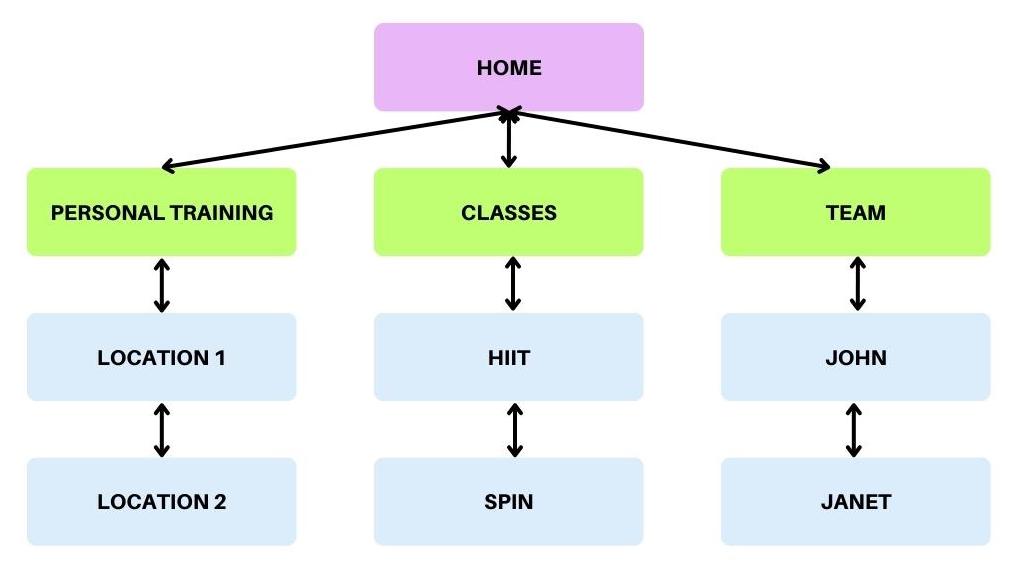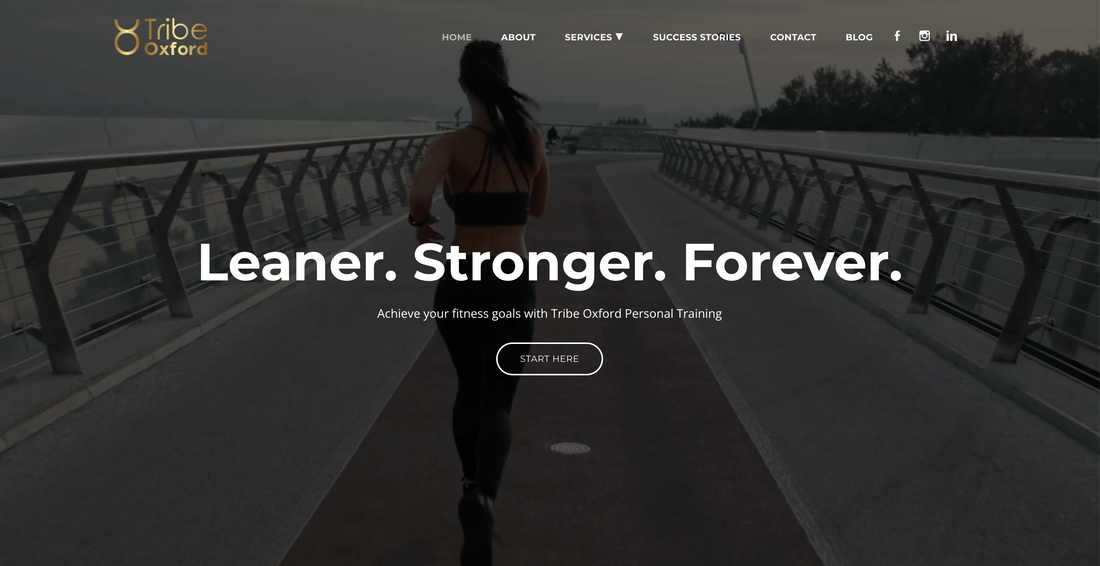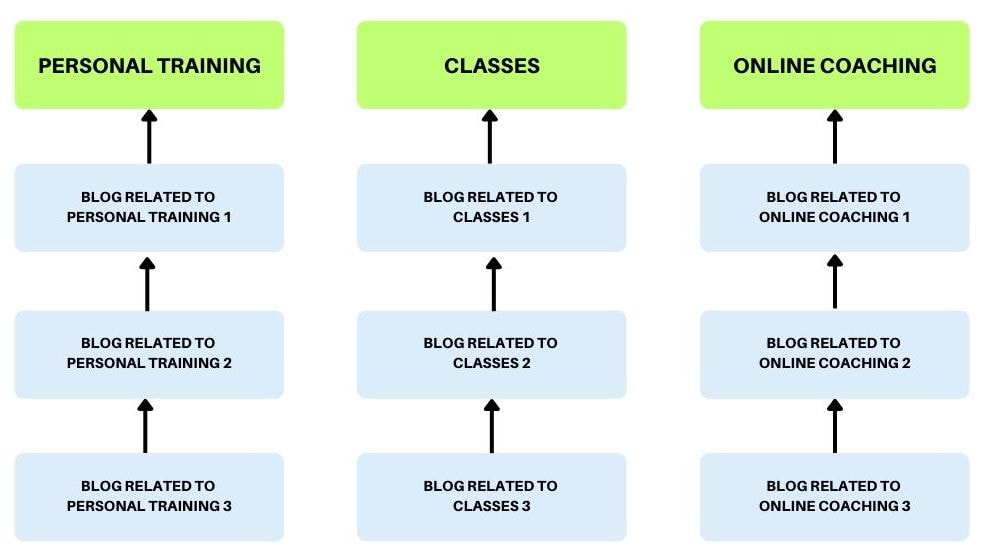If potential clients can't find your site via search engines like Google, you’ll struggle to consistently generate leads that convert into clients unless you continue to pay for ads. I don't know about you, but I'd rather not pay for ads for the lifetime of my business!
There are a handful of things you can do to get on page one of Google which starts with maintaining your fitness website, building backlinks and listing your business on Google My Business. In this guide, we'll focus on one specific thing that’ll give you a ranking boost: SEO Silos (sometimes called SEO Silo Structures).
What is an SEO Silo Structure?
SEO Silos are all to do with the structure of your fitness website. All websites are made up of numerous pages of information. You’ve got your Home Page, where a lot of your traffic initially ends up. Then you have Services pages, an About page, and hopefully a blog full of excellent fitness content.
The key to a good SEO ranking is making all these pages easy to find and navigate. You must create a solid site architecture so search engines can “crawl” your site and categorize it correctly.
The key to a good SEO ranking is making all these pages easy to find and navigate. You must create a solid site architecture so search engines can “crawl” your site and categorize it correctly.
An SEO Silo structure is a specific way of doing just that. Here, you group content around a particular topic. Each group is called a silo, and all of its pages will link to one another. Crucially, you never link to a page that’s part of another silo.
Advantages of a Silo Structure for Your Fitness Website’s SEO
The premise behind SEO silos is relatively straightforward. But why is this a beneficial approach? There are three significant advantages of a silo structure for your fitness website:
Better Organization
Few things are worse than a disorganized website. If your personal trainer website doesn't look professional, it makes it challenging for prospective clients to trust your fitness business, as your site doesn’t reflect your brand well and what you hope to achieve.
An SEO silo structure corrects this by ensuring everything has its place. Your site becomes more organized and professional, delivering a better image for your fitness brand. It also makes it easier for users to find the content they want.
Better Organization
Few things are worse than a disorganized website. If your personal trainer website doesn't look professional, it makes it challenging for prospective clients to trust your fitness business, as your site doesn’t reflect your brand well and what you hope to achieve.
An SEO silo structure corrects this by ensuring everything has its place. Your site becomes more organized and professional, delivering a better image for your fitness brand. It also makes it easier for users to find the content they want.
Website visitors who struggle to navigate your site will likely leave ASAP, resulting in a high bounce rate. Improving your site’s organization with silos could prevent this from happening.
Better Internal Linking and Overall Site Structure
Each silo is designed to link to relevant pieces of content. This drastically improves the internal linking strategy of your site. Many people focus on external links pointing to your content, but you can’t neglect the importance of a good internal linking structure.
Your improved internal linking strategy will effectively inform search engines where your best content is. It also points website visitors to relevant content relating to what they’re already taking in. You’re creating a much better experience for the user rather than including links to random blogs or pages on your site.
Easier for Search Engines to Read
Ultimately, the previous two points lead to this one. A site with an SEO silo structure is easier to read. Search engines have no issues finding your pages, figuring out the content, and placing it in the relevant searches for specific keywords.
As a result, you can boost ranking with silos. Google views your site and sees this beautiful structure, making it believe your content is worthy of being seen. Without SEO silos, it might be hard for Google (and other search engines) to understand what your pages are about. When a site is hard to read or crawl, it ranks poorly.
Disadvantages of the Silo Structure for Search Engine Optimization
As good as SEO silos are, they are far from perfect. Like most things in life, and on your fitness website, there are pros and cons. What are some of the disadvantages of SEO silos?
Extremely Difficult for Established Sites
If you have an established fitness website, it’s challenging to implement SEO silos. It would require a complete overhaul of your site architecture and content, which takes time and wouldn’t necessarily be beneficial.
Too Much Linking Can Cause UX Headaches
Giving users excellent internal links can help them get around. But, some sites take things a step too far with silo structures. Too much linking confuses the website visitor and makes navigating the site more challenging. This leads to frustrations that could see people leave before you even have a chance to convert them into clients.
Irrelevant Link Structures
The biggest issue with the silo structure for SEO is irrelevant link structures.
Only linking between similar pieces of content doesn’t always make sense. You may create irrelevant links while ignoring relevant ones. Two pages can link together perfectly despite not being in the same silo or category. Likewise, two pieces of content might be on the same topic, but that doesn’t necessarily mean they’re relevant. There could be no reason for a user to go from Page A to Page B, but the link is there anyway.
Extremely Difficult for Established Sites
If you have an established fitness website, it’s challenging to implement SEO silos. It would require a complete overhaul of your site architecture and content, which takes time and wouldn’t necessarily be beneficial.
Too Much Linking Can Cause UX Headaches
Giving users excellent internal links can help them get around. But, some sites take things a step too far with silo structures. Too much linking confuses the website visitor and makes navigating the site more challenging. This leads to frustrations that could see people leave before you even have a chance to convert them into clients.
Irrelevant Link Structures
The biggest issue with the silo structure for SEO is irrelevant link structures.
Only linking between similar pieces of content doesn’t always make sense. You may create irrelevant links while ignoring relevant ones. Two pages can link together perfectly despite not being in the same silo or category. Likewise, two pieces of content might be on the same topic, but that doesn’t necessarily mean they’re relevant. There could be no reason for a user to go from Page A to Page B, but the link is there anyway.
How to Implement a Silo Structure to Improve Your Site’s SEO
A silo structure can be beneficial if you implement it correctly. Those of you that wish to obtain a ranking boost should follow these four steps:
1. Identify Your Site's Major Categories
The first step towards creating effective SEO silos for fitness websites is to identify the major categories or themes that your site revolves around. This can include topics like cardio, weightlifting, nutrition, and yoga for blog posts, but depending on your business, you might also want to use silos like Locations, Classes, Services, etc. These will form your silos.
1. Identify Your Site's Major Categories
The first step towards creating effective SEO silos for fitness websites is to identify the major categories or themes that your site revolves around. This can include topics like cardio, weightlifting, nutrition, and yoga for blog posts, but depending on your business, you might also want to use silos like Locations, Classes, Services, etc. These will form your silos.
2. Revamp the Site Navigation to Reflect Those Topics
Once you have identified your categories, revamping your site navigation to reflect these topics is essential. This will help website visitors quickly find the content they are looking for and make it easier for search engines to understand the structure of your site.
3. Focus on Internal Linking Between Subjects
When creating silos for your fitness website, focusing on internal linking between related subjects is crucial. This means linking related content within the same silo, as well as linking to other silos on your website where relevant. This will help search engines understand the relevance of your content to specific topics and improve your overall search engine rankings.
4. Don’t Forget Your 301 Redirects
Finally, it's essential not to forget your 301 redirects when creating SEO silos for your fitness website. A 301 redirect is a permanent redirect from one URL to another and helps search engines understand that content has moved from one location to another. This is important when restructuring your website, as it will ensure visitors are directed to the correct pages and prevent any negative impact on your search engine rankings.
Conclusion
Overall, your fitness website can benefit from using SEO silos to gain search engine ranking positions. Especially if your site is relatively new and you don’t have a perfect internal linking structure. Ensure you follow the steps above if you are going through with this.
Alternatively, you can get help with your fitness website SEO by working with a professional. Don’t hesitate to get in touch with us today to learn more about how we help sites rank high in search engines and maintain an excellent website architecture.
Alternatively, you can get help with your fitness website SEO by working with a professional. Don’t hesitate to get in touch with us today to learn more about how we help sites rank high in search engines and maintain an excellent website architecture.












